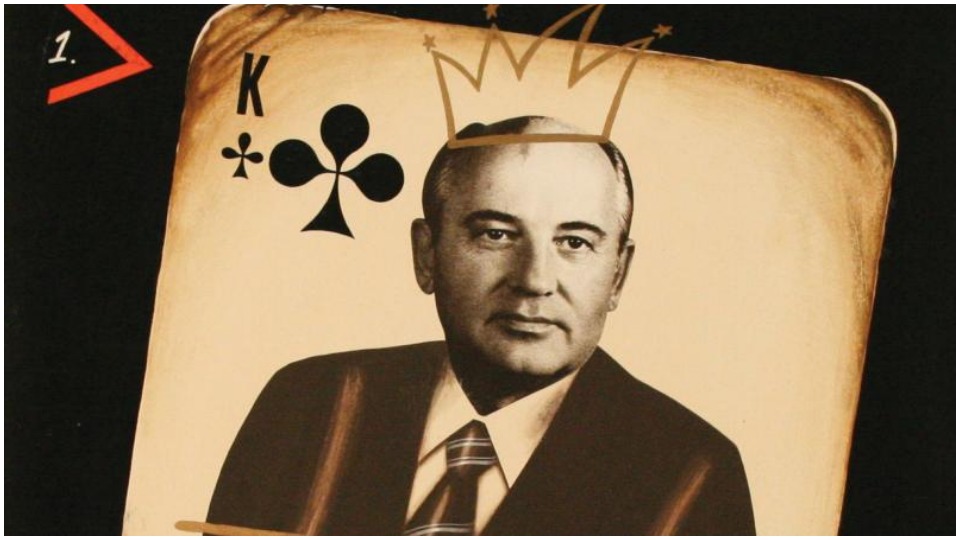
CULVER CITY, Calif.—The unique Wende Museum of the Cold War, located a few blocks west of the downtown commercial area of this small municipality embedded within the City of Los Angeles, never ceases to amaze. Its own collection numbers many thousands of individual artifacts of Eastern European life under socialism, but it also reaches out to other institutions and individuals for items on loan that can fill out the vision of a particular exhibition.
Two extraordinary exhibitions—that may raise many more questions in viewers’ minds than answers—are on view now through June 2. In the museum’s central viewing hall is “Crumbling Empire: The Power of Dissident Voices,” a remarkable collection of late Soviet (I believe all Russian) poster designs of the 1980s and early ’90s.
Apportioned space amongst the Soviet posters is a grouping of contemporary American street art by “subversive” printmaker Shepard Fairey which serves as a complementary parallel from the present and from the West to the oppositional art of the East. In a smaller viewing area toward the patio end of the building is “Upside-Down Propaganda: The Art of North Korean Defector Sun Mu.”
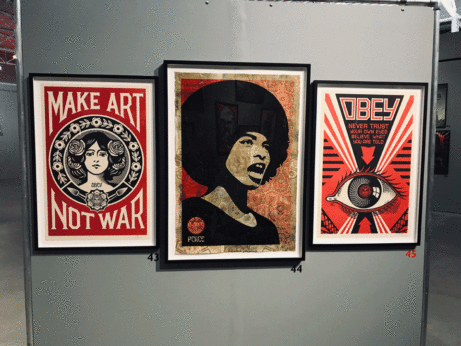
Historians and others who are intrigued by the workings of history view revolution and sudden social change basically in two large formations. One camp, favored by the left, highlights the role of revolutionary organizations, parties, and movements in overthrowing the ancien régime as a means of bolstering their own authority and authorship. For a century, models such as the Bolshevik Revolution or the Cuban Revolution, themselves quite different from one another, served as exemplars of how revolution is to be done.
In the other camp, not solely the property of the right, the ancien régime is seen as corrupt, exhausted, out of touch, bankrupt both morally and financially, abusive and discredited, and poised to topple over at the slightest breeze. Examples might include the French royal order of the late 18th century on the eve of 1789, and Russian czarism in the throes of World War I. The revolutionary forces coming up from below, in that interpretation, had little to do with the demise of the established order except to puff a gentle breath onto the domino that would set the whole row of dominoes falling.
Among left and progressive circles in the years following the fall of the USSR and the other Eastern European socialist systems, the debate has been sharp and divisive. Did socialism fall of its own unwieldy weight, finally incapable of providing acceptable democratic governance to the people who, as proof of this thesis, failed almost everywhere to rise up and defend socialist achievements? Or, on the contrary, did the evil forces of capitalist restoration seize the last Soviet premier, Mikhail Gorbachev, who, with his satanic minions, imposed “reforms” known as glasnost and perestroika, that could only—and intentionally—lead to the demise of the singular Soviet state and the redistribution of the Soviet people’s commonly held wealth to today’s oligarchs?
During this late Soviet period of glasnost (openness) and perestroika (reform), Moscow-based artists, trained in poster design, harnessed a newly freed-up countercultural energy to produce a unique series of images with a highly critical and at times ironic take on Soviet socialism.
Beverly Hills High School teacher Tom Ferris and his wife, Jeri, got to know these artists and collected hundreds of their works during their regular travels to the Soviet Union. The Wende Museum acquired 234 of these paintings from the Ferrises. A selection of the Tom and Jeri Ferris Russian Collection constitutes the bulk of “Crumbling Empire.” Additional items come from the Ron Miriello Soviet Poster Show Collection / AIGA San Diego.
Given the repression of non-approved Soviet artists in the not so distant past, it’s not surprising that artists of the 1980s used stylistic means and imagery that would have been forbidden before to express their discontent. Commonly employed portraits of communist founders Marx, Lenin, Trotsky, and Stalin and later leaders such as Khrushchev and Gorbachev, illustrate that many artists felt the problems in their society redounded to the imposition of an unwanted socialism, while in other cases it seems the complaint was more that socialism as implemented simply did not live up to its promise or was thwarted along the way—by the great purges of the 1930s, for example.
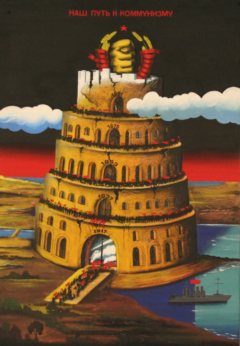
In the case of Alexei Rezaev’s image “Our Road to Communism” (1990), used as the cover of the elegantly produced exhibition catalogue, the intent is somewhat blurry. Inspired by Pieter Bruegel’s 16th-century painting The Tower of Babel, and probably meant to refer to the multitude of nationalities and ethnic and linguistic groups comprised within the USSR, each platform is dated according to a turning point in Soviet history. At base is the 1917 Revolution, then the 1937 purge, Stalin’s death in 1953, the 1975 Helsinki Accords, which would stabilize relations between the socialist and the capitalist systems, and 1991—a year before the painting was executed, if the assigned date is correct—when the USSR collapsed. Interestingly, the year 1945 is overlooked, when the Soviets preserved socialism at unfathomable cost against the Nazi foe.
Curiously, the topmost finial on communism, crushing the white towers of apartment buildings (a Soviet accomplishment, needless to say), is the fist of—what, shock capitalism? No. Rather it’s the fist of the communist state itself: Communism destroying communism. I’d like to know exactly what Rezaev was thinking.
The entire exhibition catalogue can be viewed here.
No borders
In the smaller, and equally enigmatic exhibition of the work of a North Korean defector artist who calls himself Sun Mu—a pseudonym, meaning “no borders”—the Wende presents the artist’s first U.S. museum exhibition.
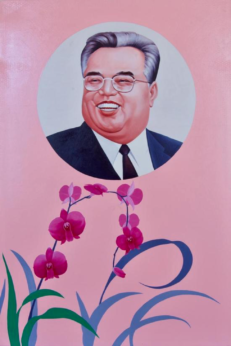
Trained as a propaganda poster artist, Sun Mu fled the DPRK in 1998, continuing to work in the style in which he once glorified the North Korean army and state leaders, but now ironically turning what on the surface appear to be propagandistic messages into their opposite.
Sun Mu’s first exhibition in Seoul was met with confused responses, as some viewers felt they were being confronted with North Korean state propaganda, and the authorities were called. In 2014, a planned exhibition of Sun Mu’s works in Beijing was canceled at the last minute, following North Korean protests.
Yet many of the paintings included at the Wende do not project sarcasm toward North Korea’s leaders or system. In one lovely floral oil painting called “North and South” (2011), the two national flowers, magnolia and hibiscus, are joined together. In other paintings, children wearing uniforms depicting both North and South Korean symbols are happily running and playing together. These paintings reflect a common aspiration of Korean unity that has been embraced by leaders on both sides. And in other works, Sun Mu depicts North Korean women who have escaped to China, and there sold off as brides or prostitutes.
Viewers may have to set some of their biases outside the door and expect to be challenged by what they see at the Wende. Click here to view the exhibition catalogue.
The Wende Museum is located at 10808 Culver Blvd., Culver City 90230. For more information, and to see hours of operations, see the Wende website.





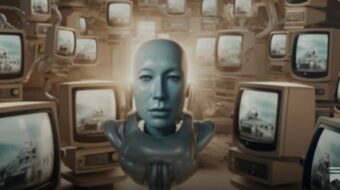






Comments